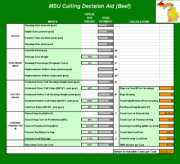



Stretching Feed Resources through Strategic Culling
By Kenny Wells, Beef Academic Specialist, Michigan State University. Published in the OSU Extension BEEF Team, Issue # 565. With hay supplies in the state extremely tight and pastures drying up completely in many areas, it is apparent that many producers will be buying hay to make it through the winter.Or is it? Could you make it through the winter on the feed you have with fewer mouths to feed? Downsizing the herd could, at least, lighten the financial load of buying hay and supplement. Take the time now to consider whether the calf weaned next fall will offset the investment in feed you will make this year. If your operation is under stress from the current drought situation, now is the time to take action. The following steps should help you to decide whether or not selling cows is the right option for you.
First, take inventory of cows and available feed, both hay and pasture. If you have pasture left, get an idea of how long it will last. If your cows are already being fed, how much feed will it take to maintain them until pasture turn-out next spring? To estimate feed usage you will need an estimate of the average weight of your cows. A mature lactating cow will usually consume around 2.5% of her body weight in dry matter (DM) daily, while a dry cow will consume 2%. Hay is generally around 85% DM. And don't forget to account for some portion of the feed being wasted (5-10%). Using these estimates you would expect to feed just over 1,000 lb of hay to a 1,300 lb cow every month (33.6 lb/day). Use these estimates to calculate how much feed you will need. Consider, whether or not culling more deeply this year would allow you to get by on the feed you have available.
Next you need to put a value on the feed you have and consider the cost of the feed that will be available for purchase. A truly economic stance would be to value the feed you have available at what it is worth in the marketplace. At the very least, you should value the forage at your cost of production. The most recent Illinois Standardized Performance Analysis (SPA) summary shows the average cost of forage production to be $48.53/Ton. As for purchasing forage, it looks like decent quality hay could be from $70/Ton to over $100/Ton this fall and winter. Remember, even if you are still grazing, there is a cost associated with pasture use. SPA data shows an average cost of about $0.54/day per grazing cow calf pair.
Now put a price on next year's calf. I realize this is tough, but most economists are forecasting relatively strong calf prices for another year. You need to do this to be able to estimate a profit or loss. When estimating returns per cow, remember, not every cow will wean a calf. Will the value of next year's calf exceed what you have invested in maintaining the cow? Harvested feed and pasture costs are a large portion of that investment, but only account for about 60% of total cow costs on an average year. Non-feed costs added up to just over $133 for the average Illinois SPA participant in 2005. Traditionally, Michigan producers have had higher cow costs than those of Illinois producers. With higher fuel prices and many producers already feeding cows, non-feed costs may be higher than ever for producers this year.
If your estimate of total cow costs for the next year adds up to more than the value of the next calf crop, you need to look for some way to cut costs. For producers who are blessed with extra feed, culling deeply may not be necessary. For those who will clearly be buying hay to maintain their current inventory, consider strategic culling to stretch your feed resources.
The following list should help you to assign priority to which cows need culled first.
- Cull Open Cows: First and foremost, in a drought/feed shortage situation open cows need to be identified early and culled.
- Cull Old Cows: Now is a prime opportunity to get rid of cows that are approaching the end of there productive lives. Ten years of age is a good rule of thumb. Their performance will only go downhill from now on.
- Cull Cows with Physical Problems: Consider culling cows with bad udders, bad eyes, feet-and-leg and structural problems, anything that might not make it through the winter and wean a calf.
- Cull Poor Performers: If you keep records on individual cow performance, now might be the time to cull those cows that consistently wean a lightweight calf.
- Cull Late Calvers: This could be an excellent time to tighten your calving season. Based on calving dates or pregnancy detection, cull those cows you expect to calve outside your normal calving window. Their calves will likely be lighter at weaning.
- Cull Cows with Bad Temperment: Even if productive, a cow with a bad attitude is a liability. A short feed supply might be just the excuse you need to cull her.
Your feed supply will play a key role in determining how far down the above list you may need to go. Other factors, such as, cow genetics and cull cow markets should also be considered when making culling decisions. Remember that culling is not the only option. There are a number of management strategies that may help to reduce feed costs and the need to cull.
If you are not comfortable budgeting your production cost over the next year, an excel spreadsheet has been developed by the MSU Beef Team as a decision making aid.
Further Reading
|
|
- You can access the spreadsheet by clicking here. |
December 2007



